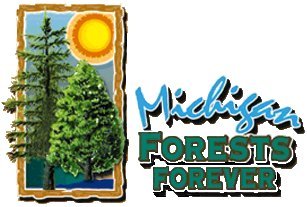

Home Page |
MICHIGAN FORESTS FOREVER TEACHERS GUIDE
| RAW WOOD PRODUCTS |
|
As trees are manufactured into a wide range of products, there are many "value-added" steps along the way. Sometimes, the value-added "food chain" can be many links long, and many chains cross-over. The web of wood products can be complex. However, in all cases, the first link in the chain has to do with products that are cut from the forest itself. We call these "raw wood" products. A logger buys standing trees (stumpage) and then manufactures value-added products. There a number of different kinds of raw wood products. "Roundwood" refers to raw products such as sawlogs, veneer, pulpwood, and poles. However, there are a number of other raw wood products, such as chips, firewood, boughs, maple sap, and Christmas trees.
| Definition - Board Foot:
A board foot is a piece of wood that is 12 inches wide, 12 inches long, and 1 inch thick.
The number of board feet in a log takes into account the shape of a log and the
amount of wood lost to saw dust when sawing. Definition - Cubic Foot: A cubic foot is a block of wood measuring the equivalent of 12 inches on all sides. A cubic foot will have less than 12 board feet because of the wood that is converted to sawdust when sawing. |
This is often the first kind of raw wood product that many people think of. These are logs cut to various lengths, from many different species, that eventually end up as lumber. In the USA, conifers make up the largest segment of lumber production. Much of our softwood (needle-bearing trees) lumber supply comes from Canada.
In Michigan, most of our sawlogs are hardwoods (broad-leaf trees). These sawlogs end up in many final products, such as furniture, window frames, pallets, moldings, and many other things.
A section of tree must meet certain specifications to become a sawlog. There are several sets of "grading rules" that spell-out these specifications. Many buyers have their own twists to the rules, as well, depending upon what they process the sawlogs into. Grading rules take into account such things as log diameter, log length, amount of rot, the number and kind of surface defects, and log curvature (or sweep). At one time, most loggers simply cut sawlogs into eight-foot lengths. Today, log lengths vary considerably and placing a cut in the right place may make a difference of hundreds of dollars. Sawlogs are usually measured in units called "board feet" or "cubic feet". The metric measure is "cubic meters".
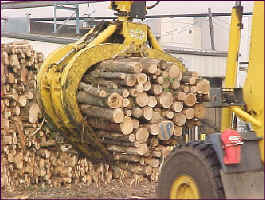 |
Smaller diameter and lower quality wood is often sorted into a pulpwood pile. Pulp sticks are often further sorted by species, depending upon which mill the logger has a contract with. Most pulpwood ends up at a pulp mill, particle board mill, or an oriented-strand board mill where it processed into pulp or board products. Bales of wood pulp are a commodity which is traded internationally. The pulp eventually gets made into paper or a paper product. Pulp and paper mills often specialize in one group of paper products, therefore require certain species of trees. Different tree species have various chemical and mechanical properties. Wood chemists know which species best produce certain kinds of paper products. Tissues and paper towels need to have the long, strong fibers found in conifers such as red pine. Fine paper used in magazines and textbooks are usually made from hardwood fibers, which are shorter and bond well with certain coatings designed to accept ink better. Board plants also have preferences for various tree species based on the products they make and the process used to make those products.
Pulpwood is measured in cords or tons. In the Lake States, a standard cord pile is four feet high, four feet wide, and made up of pulpsticks 100 inches long (eight feet plus four inches). One cord is about 79 cubic feet of solid wood within a 144 cubic foot space. Tons are usually measured by a truck scale located at the entrance of a mill. Trucks are weighed going in and going out. Prices based on weight will vary between seasons to account for the changing water content of the trees.
Having a market for low quality and small diameter wood is very beneficial to forest management. Most forest stands require a number of improvement thinnings in order to increase their value (in monetary terms, as well as visual terms and other measures). Unless these thinnings have commercial value, they are unlikely to happen. Most of the U.P. and parts of the L.P. have reasonably good markets for low quality and small diameter wood. However, forest management is economically difficult to implement in many part of Michigan due to a lack of markets for this kind of raw wood product.
Veneer Logs
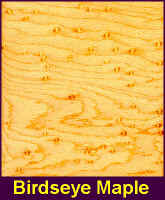 |
Veneer logs are exceptionally high quality sawlogs. Veneer is thin layers of wood either shaved or peeled from logs and extends the use of increasingly uncommon high visual quality wood by being glued over lower quality wood. Veneer is used in final products such as paneling and furniture. Birds-eye maple is a rare condition that greatly increases the value of a log. It is actually a wood defect that enhances the quality of a log. The U.P. of Michigan is one of the few places in the world where birds-eye maple is found. Specifications for veneer logs vary with each company. A reject for one operation may be prime material for another. It all depends upon what a particular company makes from the veneer, or to whom the veneer mill sells its product to.
In some parts of Michigan, entire trunks from the stump to a prescribed top diameter are delivered to mills. Usually the limbs are removed where the tree is felled and the long stems (boles) are dragged (skidded) out of the woods. This is not a particularly common harvest method in Michigan, but is quite common in other regions, such as northern Minnesota, where it is the standard way to haul wood.
Posts, Poles, Bolts, and Cabin Logs
Certain species, such as red pine and northern white-cedar, are especially popular for posts, telephone poles, and log cabin construction. Sometimes, the highest value for these tree species can be in the form of utility poles and cabin logs. In most cases, specifications for log taper and log length are demanding. Management for these kind of products can produce harvestable results in a much shorter period of time, as well as increase the number of trees that will meet specifications. Also, it usually takes less time to grow a post, pole, or cabin log than it does a large diameter sawtimber tree. A bolt has variable definitions, but is often a bit smaller than a sawlog but larger than a pulpstick. There is usually enough quality to the bolt to manufacture into something other than wood pulp oftentimes serving as logs for pallets.
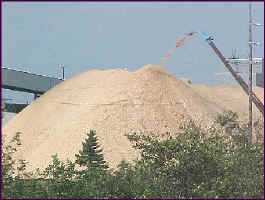 |
Wood chips can either be produced directly in the forest or as a value-added product at a mill. In Michigan, most chips are made from roundwood purchased from loggers, rather than produced in the forest. Often times, the bark needs to be removed before chipping, especially if the chips are to be used to make wood pulp. Chips might also be used for fuel, garden products, special panels, and other products. Chips made from debarked aspen are commonly made into oriented strand board in Michigan mills. Increasingly, wood chips are use to heat buildings, such as schools and hospitals.
Firewood production in Michigan coincides with peaks in alternative fuel prices. In the 1970s, fuel prices jumped as members of the OPEC nations controlled the world supply of petroleum. Many homes and businesses installed wood-using boilers. Since the 1980s, firewood production has dropped. However, there are still many people who heat their homes with wood. Some businesses, schools, and other facilities utilize wood and wood-based products for heating. Some sawmills and pulp mills will burn wood waste to help meet their high demands for power. In the home firewood market, a "cord" usually means a "face cord". A face cord is usually a stack of wood four feet high and four feet wide, but the length of log or split piece will vary with the producer. Standard cords and face cords are not the same amount of wood.
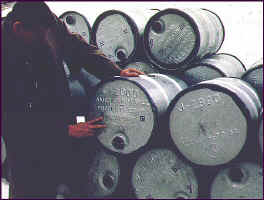 |
In February and March, maple sap is collected throughout
much of Michigan in order to produce maple syrup. Sugar maple is the most
common tree to "tap" for sap because its sugar content is particularly high,
maybe two to three percent sugar. On average, it takes about 40 gallons of sap to
produce on gallon of maple syrup. A "sugar bush" is a forest stand where
trees are tapped. Boiling the water off is energy intensive. Home sugar
bushes often use firewood as an energy source. Commercial operations might use
natural gas or other fuel sources. Collection systems may be traditional buckets
hung from taps that are collected periodically, or may be high-tech vacuum systems run
with tubing.
Christmas Trees and Boughs
Michigan is a major producer of Christmas trees. Producing a Christmas tree takes a lot of tending and protection. Markets are quite
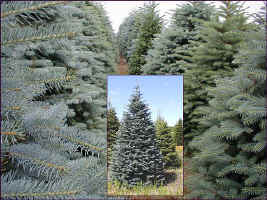 |
competitive. Growers shipped about 3.2 million trees in 1999, nearly ten percent of the national production. Most of the state’s production is exported. The most common trees produced are Scotch pine, balsam fir, Fraser fir, Douglas-fir, and Colorado blue spruce. True firs and white pine take longer to grow than some trees, but they command a better price.
Boughs are cut from many species, but mostly balsam fir and white-cedar. The boughs are used at Christmas time for wreaths and other kinds of trimming. There is also a strong market for funeral "blankets" made from boughs. Much of that market is in Chicago.
In addition to Christmas trees, boughs, and maple sap; the people of Michigan harvest many products from the forest that are NOT made of wood or not traditional wood products. Nuts, berries, medicinal herbs, mushrooms, twigs, flowers, greens, bark, and fibers are some of the items collected. People use these items for crafts, hobbies, income, ceremonial, and medicinal purposes. Much of the gathering supports important cultural and family traditions. Research on the Hiawatha National Forest revealed over 135 non-timber forest products collected by gatherers.
Woody Biomass
Using wood to replace non-renewable products involves some exciting emerging technologies, as well as some long-standing and lower-tech opportunities. Various treatments and processes can use wood to produce electricity, heat, transportation fuels, synthetic oil, waterproof pellets, various chemicals, and other interesting useful products. For example, ethanol from corn has reached billions of gallons per year and the United States leads the world in ethanol production. However, using corn has drawbacks, such as negative environmental effects, protein by-products, storage issues, etc. Wood has none of these drawbacks and is available year-round.
The easiest application is "district energy" which heats a collection of buildings from a central boiler with heat (or cooling) distributed through a hot water pipe system. There are several examples of district energy in Michigan. It's also very common in most west and north European countries. Industries, schools, hospitals, and other “big box” buildings already use wood in this way. As the scale of operation increases, a turbine might be added to the mix to also produce electricity. These "combined heat and power" plants can reach efficiencies that exceed 80 percent (much higher than traditional coal plants). Michigan also has several utilities that produce electricity only, through steam generated by burning wood.
The idea of a woody “biorefinery” can be more attractive in many ways. A facility of this nature can work in combination with more traditional power plants. However, a refinery can produce more value-added products, such as oils, ethanol, and chemicals. These products can be economically distributed great distances. More important, to some, are the reduction of greenhouse gases (mostly carbon dioxide) and relieving our national dependency on foreign oil sources.
Woody material not used for other purposes can often be used for energy generation. In parts of the state where traditional markets are lacking, nearly any wood product can be used for energy. Most wood-based energy facilities will use material potentially competitive with other industries. Care must be taken to place new energy facilities in regions of the state where wood is available.
 |
This website was developed and created by Michigan State University Extension for the teachers of the State of Michigan. |